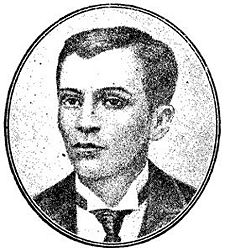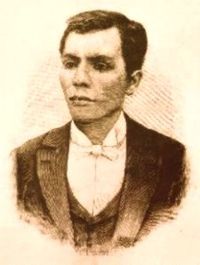Andrés Bonifacio
| Andrés Bonifacio y de Castro | |
 |
|
| Born | 30 November 1863 Tondo, Manila, Philippines |
|---|---|
| Died | 10 May 1897 (aged 33) Maragondon, Cavite, Philippines |
| Cause of death | Execution |
| Nationality | Filipino |
| Other names | Maypagasa, Supremo |
| Known for | Philippine Revolution |
| Political party | La Liga Filipina Katipunan |
| Spouse(s) | Gregoria de Jesus |
Andrés Bonifacio y de Castro (November 30, 1863 – May 10, 1897), son of Santiago Bonifacio and Catalina de Castro, was a Filipino revolutionary leader and one of the main rebel leaders of the Philippine Revolution against Spanish colonial rule in the late 19th century. He is regarded as the "Father of the Philippine Revolution" and one of the most influential national heroes of his country. A freemason, Bonifacio was the founder of the Katipunan organization which aimed to start an independence movement against Spain.
Contents |
Early life
Bonifacio was born to a Tagalog father by the name of Santiagos Bonifacio, and a Spanish mestiza mother, Catalina de Castro of Zambales,[1] in Tondo, Manila. His father was a cabeza de barangay (a leading barangay official). His mother died of tuberculosis in 1881 and his father followed suit a year after. According to popular anecdote, he peddled canes and fans to support his family.
He worked as a clerk and sales agent for Fleming and Company, a British trading firm, then transferred to Fressell and Company, a German firm, both in Manila. He married twice - his first wife was a woman named Monica, who died of leprosy, and Gregoria de Jesus, daughter of a wealthy family in Binondo. They were married in Binondo Church, despite her parents' objections.
Bonifacio, though projected by detractors as being illiterate, was in fact highly literate. He was taught Spanish since childhood owing to his mother's ancestry. He was also a fervent reader - his favorites were books on the French Revolution, The Lives of the Presidents of the United States of America, Victor Hugo's 'Les Miserables' (which he translated into Tagalog), and Jose Rizal's 'Noli me Tangere' and 'El Filibusterismo'. Furthermore, the title 'bodeguero' would have the modern equivalent of a warehouse/inventory keeper, a job that would require adequate to above-average intelligence. He also wrote various revolutionary articles, manifestos, and poems, the most famous being 'Pag-ibig sa Tinubuang Lupa'.
He was a Freemason. He also joined Rizal's La Liga Filipina (Spanish "The Philippine League"), a society that called for reforms in Spanish rule. However, the Liga was disbanded shortly after Rizal was arrested and deported to the town of Dapitan in Mindanao a day after the group's only meeting.
After the La Liga was disbanded, Bonifacio realized the futility of peaceful struggle even for mere reforms. He then founded the underground organization that in the coming years would grow and send shock to the Spanish colonial rule and would drastically change the course of Philippine history and would give pride to every Filipino - the Katipunan. With his wife Gregoria de Jesus and his uncle one day in a humble hut in Manila, Bonifacio resolved to change history with just a single pistol in hand for a start.
Controversy

Some historians, like Renato Constantino, see him as a champion of the masses who was slighted by ambitious members of the upper class. Others like Gregorio Zaide, favor Aguinaldo and company over him. Glenn Anthony May goes as far as saying that his role as a national hero was largely invented. Also, until now, there is debate whether he should be considered the first Philippine President instead of Aguinaldo and the national hero instead of Rizal.
Some analytical historians like Alejo Villanueva claim that what happened at Tejeros, Cavite was actually a coup de etat to wrest power from Bonifacio by the bourgeois or upper class represented by Aguinaldo. (Aguinaldo and members of his class enjoyed more privilege status even before the revolution. They would not allow a victorious president Bonifacio ordering land and wealth distribution as his first decree.) Hence, the Tejeros Convention was a farce intended to lure Bonifacio to the Caviteño territory. The presidential election wasn't a national election at all. Participation in the election primarily came from Caviteños. The other provinces in revolt, such as Bulacan, Pampanga, Tarlac, Laguna, and Batangas, were not participants. Bonifacio, who was too fueled with idealism, was too naive to understand maneuvering politicians. Had Bonifacio been able to get back to Manila he could have charged Aguinaldo and other Caviteño officers with treason and Philippine history would have taken a very different track. Bonifacio was not allowed to get out of Cavite. He was summarily tried then executed promptly with his borther Procorpio Bonifacio at a mountain in Maragondon, Cavite for treason.
Today
Bonifacio's birthday on November 30 is celebrated as Bonifacio Day (Filipino: Araw ni Bonifacio) and is a public holiday in the Philippines.
There are many monuments to Bonifacio across the nation, the most famous being two sculptures, one by Napoleon Abueva and the other by Guillermo Tolentino, both National Artists.
In current Philippine currency, he is depicted in the 10-peso bill (currently out of production) and 10-peso coin, along with fellow patriot Apolinario Mabini.
In film
Bonifacio was portrayed by Julio Diaz in Bayani (Hero), a feature film loosely based on his life directed by experimental auteur Raymond Red, and an educational television series also named Bayani.
Gardo Verzosa portrays Bonifacio in the 1998 film José Rizal.
Dennis Trillo will play the leading role in 2009 biopic film Andres Bonifacio
Notes
- ↑ Interesting facts about Zambales, visitzambales.com, http://web.archive.org/web/20070703155058/www.visitzambales.com/newlayout/index.php?action=people&part=intfacts, retrieved on 2008-03-21 (archived from the original on 2007-07-01)
References
- Zaide, Gregorio F. (1984). Philippine History and Government. National Bookstore Printing Press.
- Ocampo, Ambeth. Bones of Contention: The Bonifacio Lectures
- Agoncillo, Teodoro. The Revolt of the Masses: The Story of Bonifacio and the Katipunan
- Constantino, Renato. The Philippines: a Past Revisited
- Guerrero, Milagros, Andres Bonifacio and the 1896 Revolution, National Commission for Culture and the Arts, http://www.ncca.gov.ph/about_cultarts/articles.php?artcl_Id=5, retrieved on 2008-03-21
Further reading
- Cruz, Isagani A. (November 27 2005). "The Tragedy Of Andres Bonifacio". Philippine Daily Inquirer: 14. http://bailey83221.livejournal.com/84994.html.
- Clair, Francis St. (1902). The Katipunan: Or, The Rise and Fall of the Filipino Commune. Francis St. Clair.Full book on Google
- Quezon III, Manuel L. (November 21 2005). "The Supremo Lives". Philippine Daily Inquirer. http://bailey83221.livejournal.com/84994.html#cutid2.
- Lazaro, Roberto (November 29 2005). "Thinking Aloud Dead Ends Need Not Be Dead". Manila Times. http://bailey83221.livejournal.com/84994.html#cutid3.
- Ramos, Marlon (December 9 2004). "Bonifacio: The Neglected Hero". Philippine Daily Inquirer. http://bailey83221.livejournal.com/84994.html#cutid4.
- Ocampo, Ambeth R. (December 1 2004). "Where Are the Bones of Bonifacio?". Philippine Daily Inquirer. http://bailey83221.livejournal.com/84994.html#cutid5.
- San Luis, Fr. Bel R. (November 29 2004). "Bonifacio & our changing notion of 'hero'". Opinion & Editorial Manila Bulletin. http://bailey83221.livejournal.com/84994.html#cutid6.
- "Cavite to Unviel Bonifacio Mural Inquirer". Philippine Daily. November 2004. http://bailey83221.livejournal.com/84994.html#cutid7.
- De Vera, Ellalyn B. (November 27 2004). "Andres Bonifacio: The Katipunan Supremo". Manila Bulletin. http://bailey83221.livejournal.com/84994.html#cutid8.
External links
- Andres Bonifacio: the Betrayal of a Hero by Alixander Haban Escote
- The Records of the Court Martial of Andres and Procopio Bonifacio Full text and online collection of court documents in Spanish and old Tagalog with regards to the Andres and Procopio Bonifacio trial.
- The Courtmartial of Andres Bonifacio English translation of the historical court documents and testimonies in the trial and execution of Andres and Procopio Bonifacio processed by Filipiniana.net
- Ang Dapat Mabatid ng mga Tagalog Summary and full text of an article written by Andres Bonifacio in the Katipunan newspaper Kalayaan posted in Filipiniana.net
- Book Review Inventing a Hero by Glenn May
- Kartilyang Makabayan Short biography of Andres Bonifacio written by Hermenegildo Cruz.
- A site on the Supremo and the Katipunan
- Andres Bonifacio and the 1896 Revolution
|
||||||||||||||
|
|||||